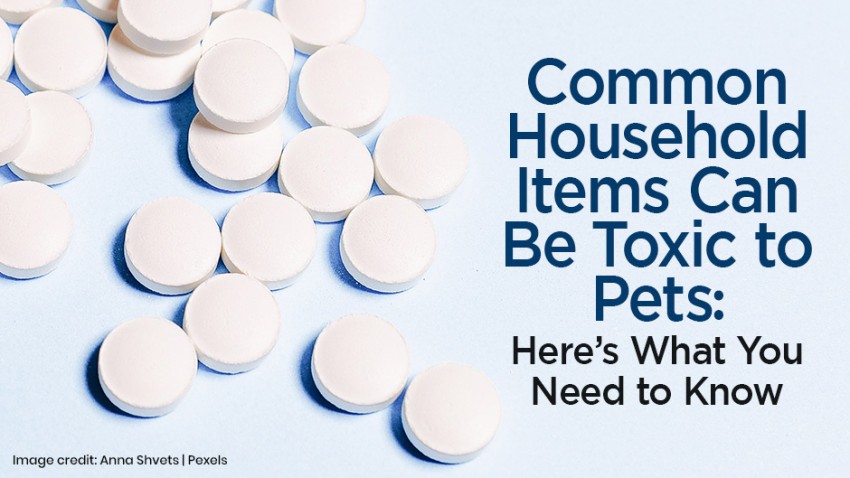Common Household Items Can Be Toxic to Pets: Here’s what you need to know

March is Pet Poison Prevention Month. Many pet owners are surprised by the number of seemingly harmless items around the house that can cause serious injury or death for cats and dogs. To help you march through this spring and into the rest of the year with a safer home for your animal companions, here are the most common and dangerous household poisons to keep away from your pets.
Chocolate
Most pet owners know to not feed their dog or cat chocolate, but this sweet indulgence still tops our list because sneaky canines can get into their humans’ chocolate stash and wind up in a world of trouble.
Chocolate contains a toxic combination of caffeine and a molecular compound called theobromine. Your dog or cat cannot metabolize these the way humans can, resulting in a racing heart and overly stimulated nervous system. While a small amount of chocolate will likely only cause an upset stomach and diarrhea, larger amounts can lead to seizures or a heart attack.
Darker chocolate is more dangerous as it contains more theobromine and it doesn’t take much to reach toxic levels. A 50-pound dog may show serious signs of poisoning if they ingest just an ounce of baker’s chocolate.
Keep your chocolate stash safely stored and educate your kids about how toxic chocolate is to their furry friend. Teaching your kids about the dangers of their favorite sweets can help keep your pets safe.
Xylitol
Xylitol may sound like a substance you’d find on a science fiction movie, but it’s actually a common sugar substitute. Commonly labeled as “sugar alcohol” on an ingredients list, a small amount of something containing it could send your dog or cat to the emergency room. Xylitol creates a sudden rush of insulin through your pet’s body, resulting in dangerously low levels of blood sugar, causing shock, seizures, lethargy, liver failure, and potentially death.
Xylitol is commonly used in
- Toothpaste
- Mouthwash
- Sugarfree gum
- Vitamin gummies
- Baked goods
- OTC medicines
- Lotion
- Sugar-free peanut butter
Typically, dogs are more susceptible to xylitol poisoning than cats, since cats don’t have the tastebuds that allow them to detect and appreciate sweet flavors.
Grapes and Raisins
Some dogs can eat grapes while others can be fatally poisoned by just a few. There is currently no conclusive research to explain why grapes can be so toxic to dogs or any “safe” amount they can have, so it’s best to avoid them completely.
Fig bars, granola bars, or other snack bars might include the dried fruit, so be sure to read the ingredients list closely if you’re sharing your snack with your pal.
Hops and Alcohol
We know these may seem obvious but there’s been a recent increase in pet poisoning related to home brewing. If you have gotten into the hobby of fermenting your own wine or beer, carefully store your supplies.
Over-the-Counter and Prescription Medications
Our pets are naturally curious, and while medications often come in child-proof containers, they’re not necessarily pet-proof. Some of the most common ways pets become poisoned is by ingesting medications meant for humans.
Which medications pose the biggest threat to pets?
- Cold medicine
- Allergy medication
- Vitamins (especially vitamin D3)
- Minerals
- Ibuprofen
- Acetaminophen
- Antidepressants
- ADD & ADHD Medications
- Cardiac medications
What You Can Do to Protect Your Pet from Poisons
We all do our best to protect our pets but accidents happen. Familiarize yourself with the common symptoms of poisoning and watch for signs of mischief in your kitchen, bathroom, and laundry room. Create and regularly review an emergency plan for your pet ingesting something poisonous. Make sure you know the location of the nearest emergency animal hospital at home or on the road.
Save our number, a local emergency vet, and the ASPCA Animal Poison Control Center in your phone. If you suspect your cat or dog may have eaten something toxic or gotten into a dangerous substance, give us a call immediately. If we’re not open, call the emergency vet or Poison Control at (888) 426-4435. The ASPCA line charges a fee for calls but can give you accurate and helpful advice that may save your pet’s life.
Save any packaging from the product you suspect your pet ingested and bring it with you if you’re directed to bring your pet to be seen by a veterinarian. Do not induce vomiting unless you are explicitly directed to do so by a professional.
When it comes to your pet and possible poisons, you’re always better safe than sorry. Survey your home and make sure the cabinets where you store your cleaners, medications, and dry goods are pet-proofed. Read the label of products before bringing them into your home and only feed your pals treats created specifically for them. If your pet is showing any signs of being poisoned, like vomiting, lethargy, or if you simply find a package with bite marks in it and someone is looking extra guilty, give us a call right away.
